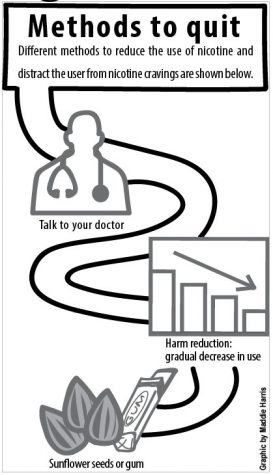The path to quitting nicotine

Waking up every morning craving nicotine, enduring headaches and feeling restless without it, a student, who wishes to remain unnamed, soon realized he was addicted and needed help.
“You get headaches, and it’s the only thing on your mind,” said the student in a phone interview. “The only thing you’re thinking about is getting that hit.
“It takes over your brain.”
According to Michelle Heyland, director of The Psychiatric Nurse Practitioner program at Rush University Medical Center, an addiction is an inability to stop a behavior despite knowing there are consequences.
“Nicotine itself is known to be one of the most addictive substances in the world, … more addictive than cocaine,” Heyland said.
Although some students may be hesitant to talk to their parents or doctor about their nicotine addiction, Heyland said she believes it is very helpful for recovery.
The student said, “First, I talked to my parents, and they completely understood because they knew how big of a problem it is with teenagers my age, and after that, we talked to the doctor.
“He was extremely surprised and happy because he told me I was one of the few people who actually stood up and [recognized] their addictions.”
Heyland said when most people try to quit cold turkey, they are just setting themselves up for failure. A more effective method for students looking to battle nicotine addiction is harm reduction.
“The concept of harm reduction is a gradual decrease in use [while] celebrating the fact that you’re decreasing,” Heyland said.
Although the student’s doctor never used the terminology “harm reduction,” the student said he first decreased the strength of nicotine from 5 percent juice to 3 percent. Then, he limited the number of times he used the nicotine device each day.
Heyland said, “[Harm reduction] can be a great way to succeed because not only are you not … feeling defeated because you’re not able to just quit right away, but you are reducing the amount of harm you’re doing to your body because you inevitably are decreasing the amount of [nicotine use].”
According to the student, he also used sunflower seeds as a replacement for his urge to use nicotine.
“It’s just having something in your mouth,” said the student. “You get distracted from the [nicotine] craving.”
According to Heyland, changing parts of one’s daily routine, including where he or she hangs out, is another important step to recovery.
The student said he often experienced headaches when he went to a particular restroom because he was so accustomed to using nicotine there. After changing the restrooms he used, his headaches went away. Eventually, he was able to resume using the initial restroom without suffering from any headaches.
According to Heyland, one’s living environment must be considered to avoid nicotine addiction to begin with.
“Oftentimes we have to look at changing the environment around the person so that they know that it’s not safe, not healthy [and] create an environment where they won’t feel like they can use it,” Heyland said.
The student said quitting nicotine was one of the hardest challenges he had ever overcome.
“The reason that made me quit was … that if I don’t do it now, then I’m just going to be addicted my whole life.”

